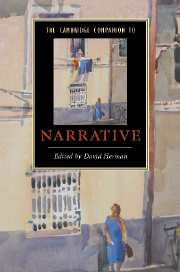Book contents
- Frontmatter
- Part I Preliminaries
- Part II Studying narrative fiction: a starter-kit
- Part III Other narrative media (a selection)
- Part IV Further contexts for narrative study
- 13 Gender
- 14 Rhetoric/ethics
- 15 Ideology
- 16 Language
- 17 Cognition, emotion, and consciousness
- 18 Identity/alterity
- Glossary
- Further reading
- Index
17 - Cognition, emotion, and consciousness
from Part IV - Further contexts for narrative study
Published online by Cambridge University Press: 28 September 2007
- Frontmatter
- Part I Preliminaries
- Part II Studying narrative fiction: a starter-kit
- Part III Other narrative media (a selection)
- Part IV Further contexts for narrative study
- 13 Gender
- 14 Rhetoric/ethics
- 15 Ideology
- 16 Language
- 17 Cognition, emotion, and consciousness
- 18 Identity/alterity
- Glossary
- Further reading
- Index
Summary
When he saw Freddy Malins coming across the room to visit his mother Gabriel left the chair free for him and retired into the embrasure of the window. The room had already cleared and from the back room came the clatter of plates and knives. Those who still remained in the drawing-room seemed tired of dancing and were conversing quietly in little groups. Gabriel's warm trembling fingers tapped the cold pane of the window. How cool it must be outside! How pleasant it would be to walk out alone, first along by the river and then through the park! The snow would be lying on the branches of the trees and forming a bright cap on the top of the Wellington Monument. How much more pleasant it would be there than at the supper-table!
At this point in “The Dead,” the last short story included in James Joyce's 1914 collection Dubliners, Gabriel Conroy is taking a moment by himself just before dinner is served at the holiday party hosted annually by Gabriel's two aunts, Kate and Julia Morkan, and by their niece, Mary Jane. Gabriel is trying to prepare himself for the speech he is to deliver after dinner. This moment is followed in turn by a life-changing revelation by his wife, Gretta, who tells Gabriel about how a young man named Michael Furey in effect chose her over life itself, standing out in a cold rain in ill-health for one last chance to see her. Below I provide a fuller synopsis of “The Dead” as a basis for exploring the crucial role that representations of consciousness play in the narrative as a whole; but let me dwell for a moment on the many manifestations of Gabriel's mind in just these few lines. Building on work by narrative scholars such as Alan Palmer and Ralf Schneider, my preliminary discussion suggests that analyzing fictional minds like Gabriel's entails giving an account of readers' minds, too - of how readers interpret particular textual details as information about characters' attempts to make sense of the world around them.
- Type
- Chapter
- Information
- The Cambridge Companion to Narrative , pp. 245 - 259Publisher: Cambridge University PressPrint publication year: 2007
- 21
- Cited by

